Butterscotch Tart is another one of those moreish desserts, like Cornflake Tart, where you grew up in the UK and had school dinners, you will have 100% tried.
It doesn’t matter where you grew up in Great Britain; dinner ladies served Butterscotch Tart to Britain’s children in some shape or form. Just like Old School Cake and pink custard.
It’s hard to imagine giving such a large amount of sugar to primary-age children being a good idea, but there you go. It was the 80s!
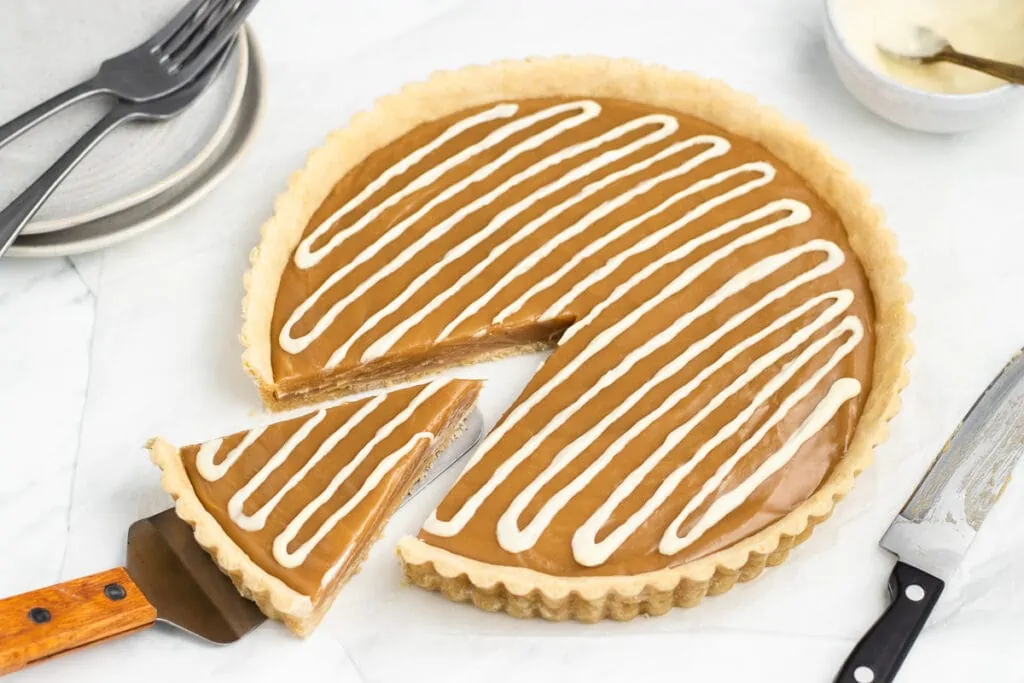
Why Make Butterscotch Tart?
Phil grew up in the southeast of England and has fond(ish) memories of his school dinners throughout the 80s and 90s. So naturally, trying a Butterscotch Tart recipe was a nostalgic no-brainer for us.
Could we recreate a section of Phil’s childhood? We thought we’d give it a go.
Is a Butterscotch Tart Scottish – How?
When researching Butterscotch Tarts and butterscotch itself, we did find some suggestions that it began life in 1667, Scotland. However, popular opinion (and Wikipedia) states it was created in mid-19th century Yorkshire.
The name Butterscotch could then suggest its origin or mean butter scorched. The choice is yours.
ButterScotch Tart came later, following some of the same recipes but maintaining a much lighter consistency than the boiled, hard butterscotch sweet.
This lack of Scottish ancestry didn’t stop us from recreating the recipe. After all, ButterScotch Tarts have been enjoyed in schools across Scotland as much as anywhere else in the country!
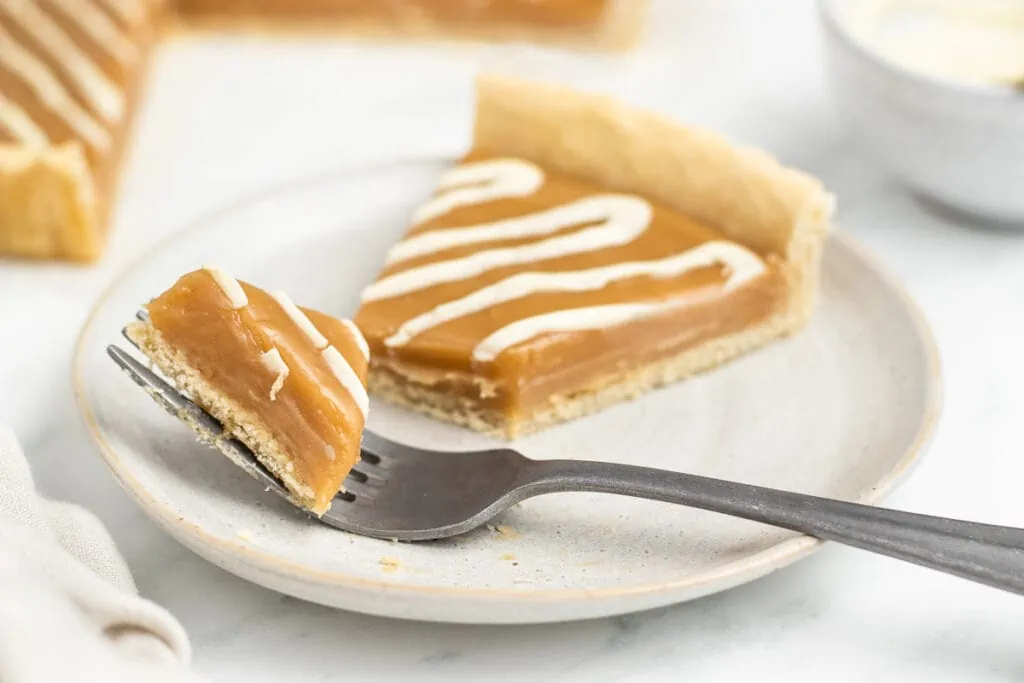
What is a Butterscotch Tart?
Other than Butterscotch Tarts being a nostalgic taste trip down memory lane, this old-school recipe is a tasty treat and so easy to make!
A Butterscotch Tart tastes like browned butter, caramelised cream, and sugar, sometimes with a touch of salt to cut through the sweetness.
What’s the difference between Butterscotch Tart and Gypsy Tart?
Growing up in Kent, Phil was particularly excited to make this old-school classic. Where he grew up, a school dinner was made complete when ‘Gypsy Tart’ was on the menu. A dessert that was very similar to a Butterscotch Tart.
The difference between Gypsy Tart and Butterscotch Tart is the milk and sugar used. Gypsy Tart is made with evaporated milk and dark brown sugar, unlike Butterscotch Tart, which is made with whole milk and light brown sugar.
These differences mean Butterscotch Tart’s filling is smooth and caramel-like, whereas Gypsy Tart has a firm, foam-like consistency. Both are awesome.
Though Butterscotch Tart isn’t quite the same as the fondly remembered Gypsy Tart, it is now preferred in our house!
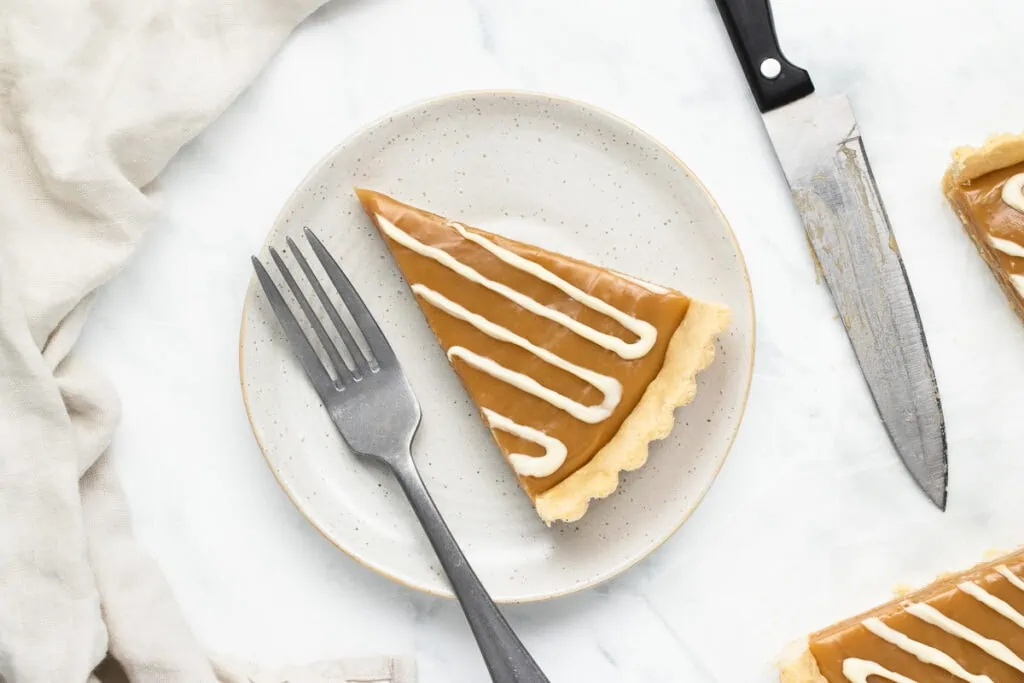
Things you’ll need to make Butterscotch Tart
- 23cm Fluted Tart Tin – we use one like this
- Large Bowl
- Wooden Spoon for mixing – means less breakage of the cornflakes
- Baking Beans** – we have these
- Food Processor**
- Stand Mixer**
** These are all useful if you want to make your own pastry but are not strictly necessary. It’s possible to use rice instead of baking beans. You can use your hands (make sure they’re cold) to combine butter and flour and a fork to bring everything together rather than a food processor or stand mixer. More detail in the recipe below! It will just take a bit longer and be more labour-intensive – but it’s worth it, we promise!
Ingredients for Butterscotch Tart
For the pastry
- 275g plain flour (2 cups)
- 125g unsalted butter (cold, cubed) (1/2 cup + 1 tbsp)
- 3 tbsp sugar
- 1 large egg
- 1-2 tbsp cold water
For the filling
- 280g unsalted butter (1 ¼ cups)
- 170ml whole milk (2/3 cup)
- 280g light brown sugar (1 1/3 cups + 1 tbsp)
- 6 tablespoons plain flour
- ¼ teaspoon salt (optional – for a salted butterscotch tart)
For decoration
- ¼ cup white chocolate chips
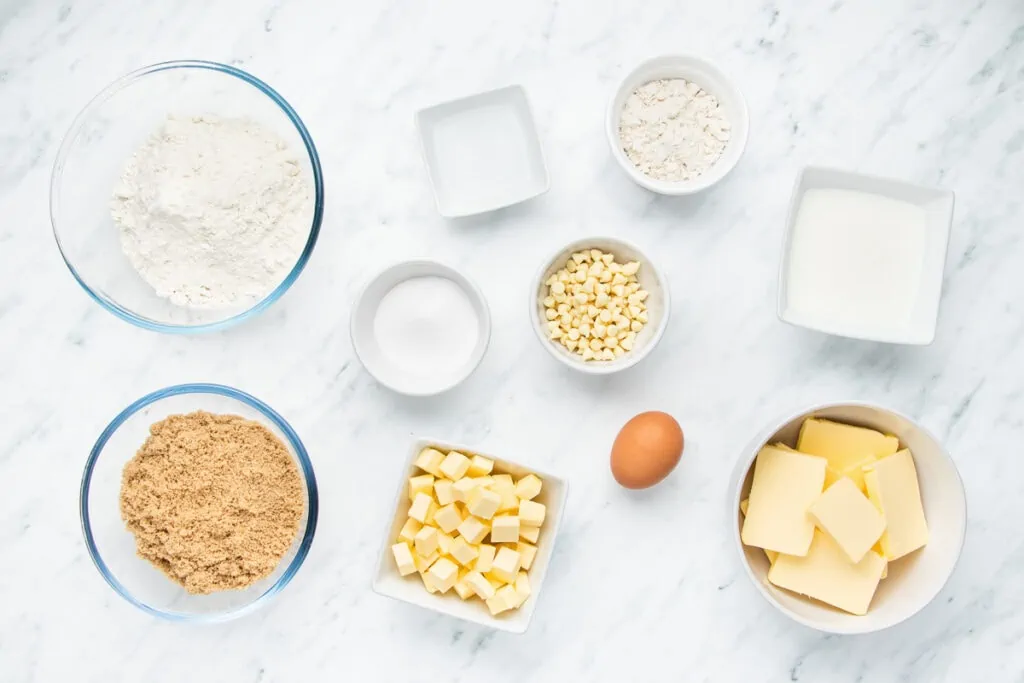
Can I add Salt to My Butterscotch Tart?
Yes, yes and yes! We’re huge fans of salted caramel anything here at Scottish Scran. Adding a little salt to our recipe gives it that touch of savoury that can really help balance the sweetness.
We’ve added salt as an optional ingredient in the recipe in case you want to try a Salted Butterscotch Tart.
Different Toppings for Butterscotch Tart
Butterscotch Tart can be served without any toppings at all! However, if you want to decorate it a little, there are plenty of options.
- Chocolate Drizzle (white, milk, or dark)
- Popcorn (usually the salted variety)
- Piped Cream
- Pecans (or other nuts of your choice)
- Maltesers or other similar chocolates
- Chocolate shards or grated chocolate
As you can see from our images, we opted for a white chocolate drizzle this time around. White chocolate is quite sweet on its own, so sometimes we prefer to use a dark chocolate drizzle if we want to break up the sweetness, which also goes particularly well when you opt to add salt for a salted Butterscotch Tart.
We have also seen people adding whisky to their Butterscotch Tarts, mainly due to the addition of the word scotch in the title. We’ve not tried this but you can add a dash when you’re making the topping if this sounds like your cup of tea. Needless to say this is not what you will have tried at school!
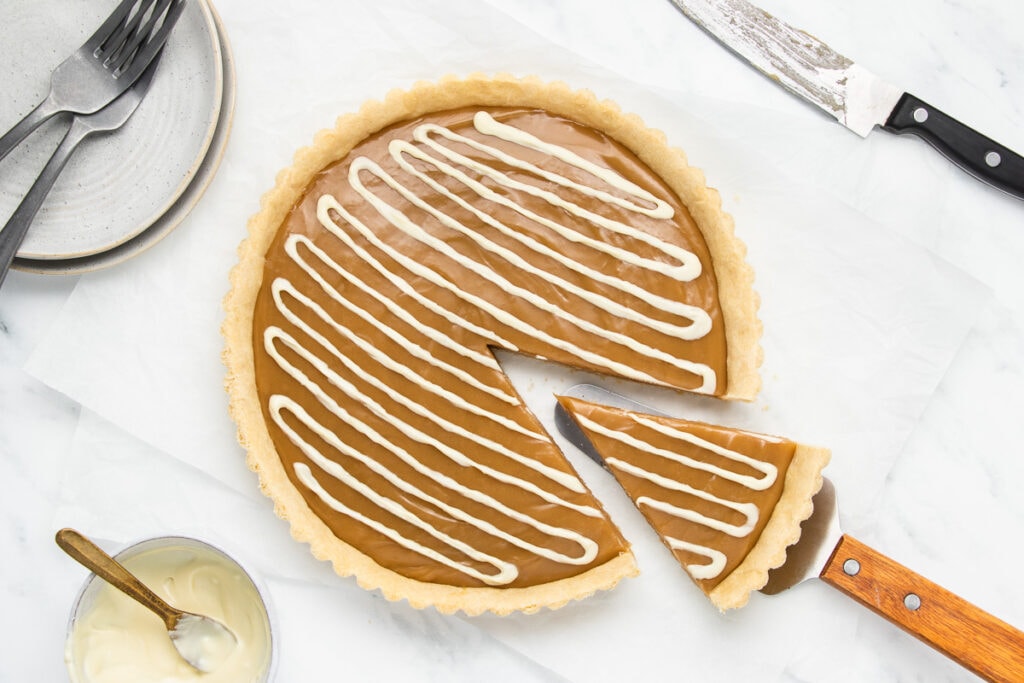
How to Make Butterscotch Tart – Step by Step Method
To make the pastry, first add the flour and butter to the bowl of a food processor. Pulse until the mixture resembles breadcrumbs. You can also rub together the flour and butter with your hands if preferred (just make sure they’re cold).
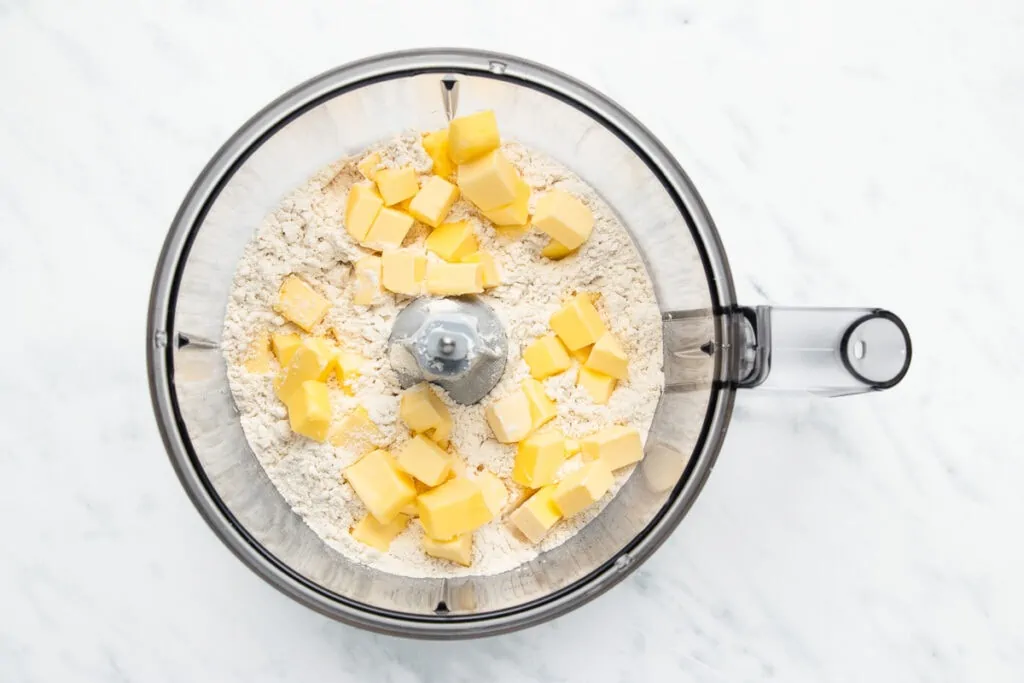
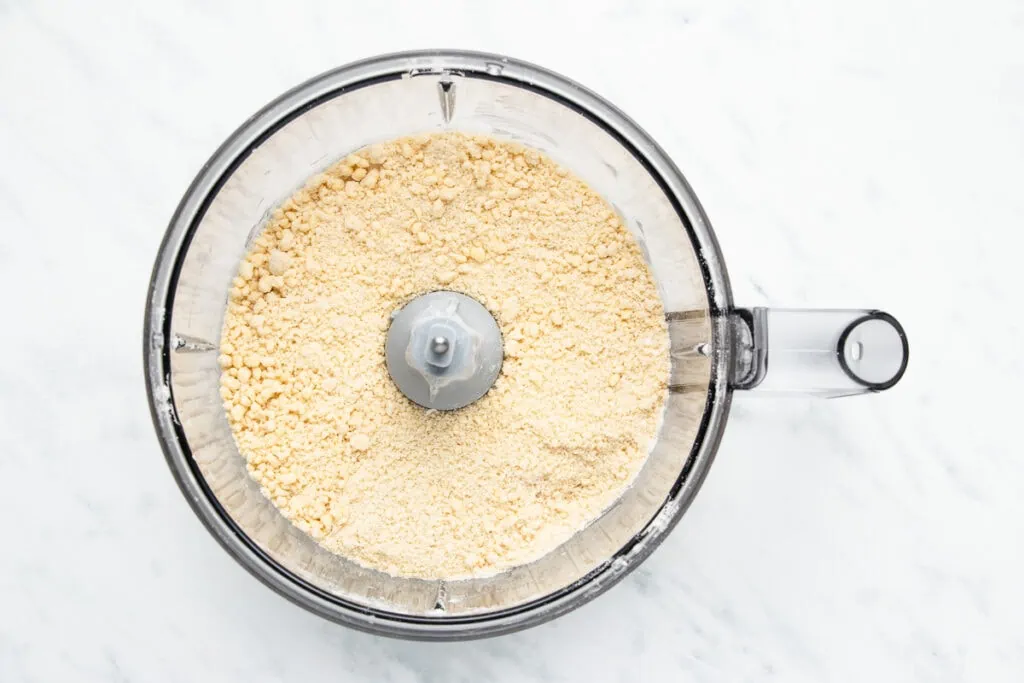
Transfer the mixture to the bowl of an electric stand mixer. Add the sugar and whisk briefly by hand to combine.
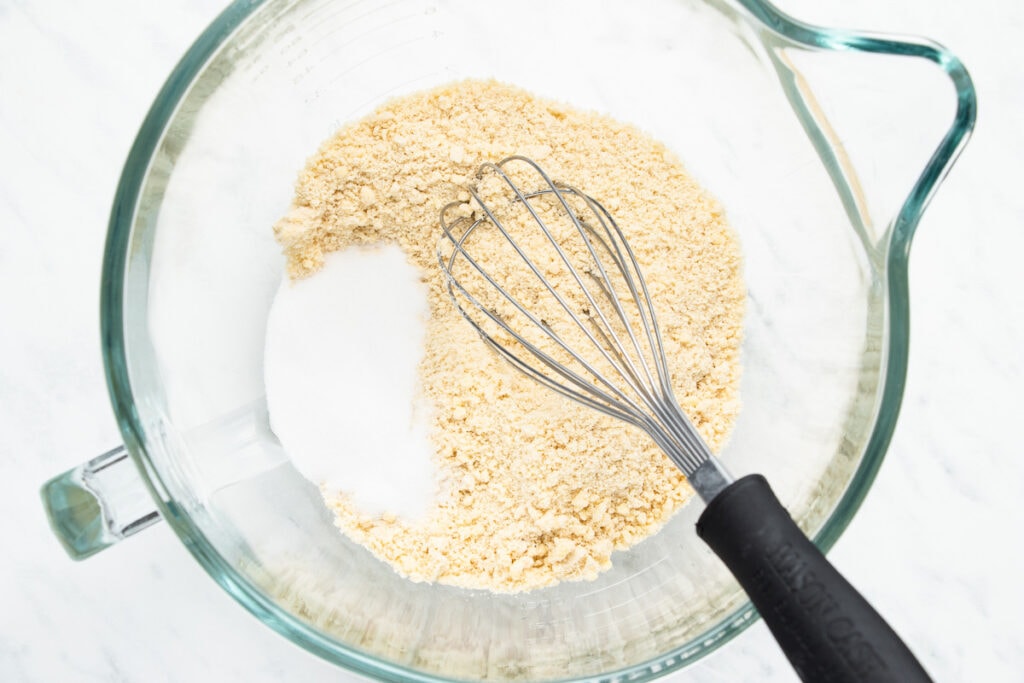
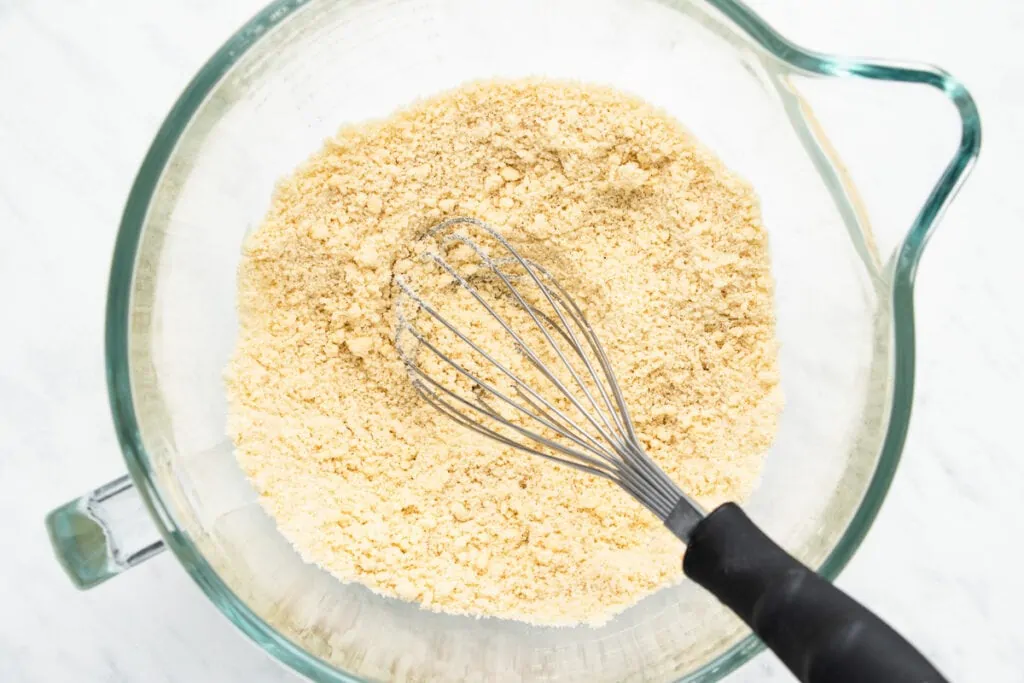
Make a well in the centre of the mixture and add the egg and 1 tbsp of the water. Using the dough hook attachment, mix on a slow speed until it just starts to come together into a dough. If the dough is still looking too dry and crumbly, add the second tablespoon of water. If you don’t have a stand mixer, you can also use a fork to bring everything together.
Use your hands to shape the dough into a ball. Don’t handle it more than you need to here or you may overwork the dough.
Wrap the dough ball in cling film and place in the fridge to chill for 30 minutes.
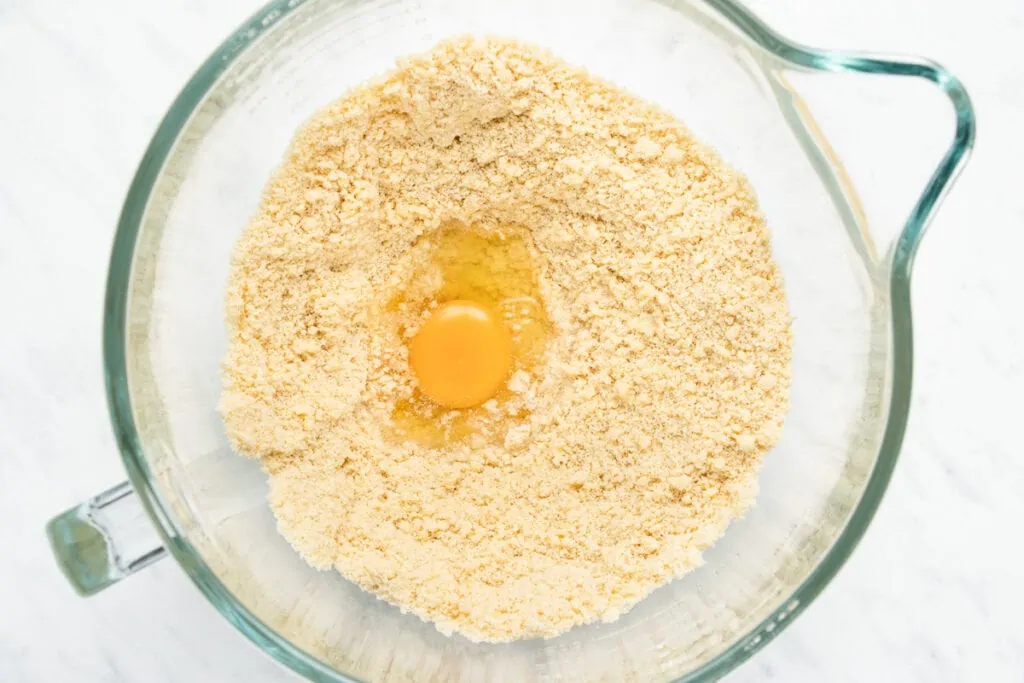
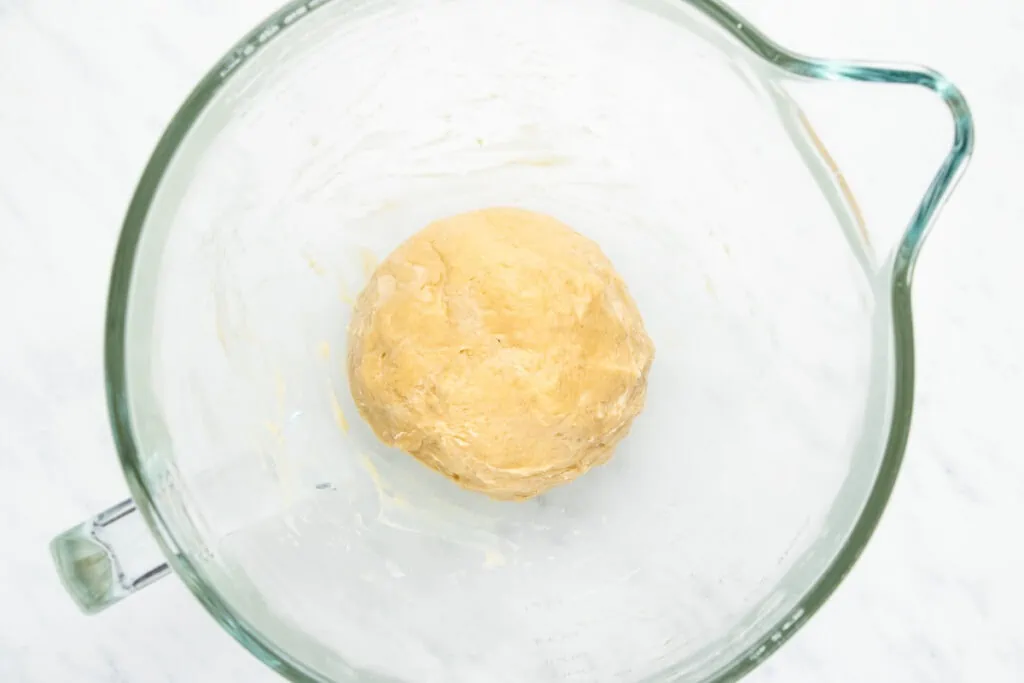
On a lightly floured surface, roll out the dough to approximately 0.5cm in thickness. Lay it over a 23cm fluted tart tin then push it down into the base and sides with your hands so it closely lines the tin. Cut away any loose edges, but leaving an overhang of about an inch or so.
Prick the base of the pastry a few times with a fork, then place in the fridge to chill for another 30 minutes.
Preheat the oven to 190C.
Place a sheet of baking paper over the pastry, then cover with baking beans.
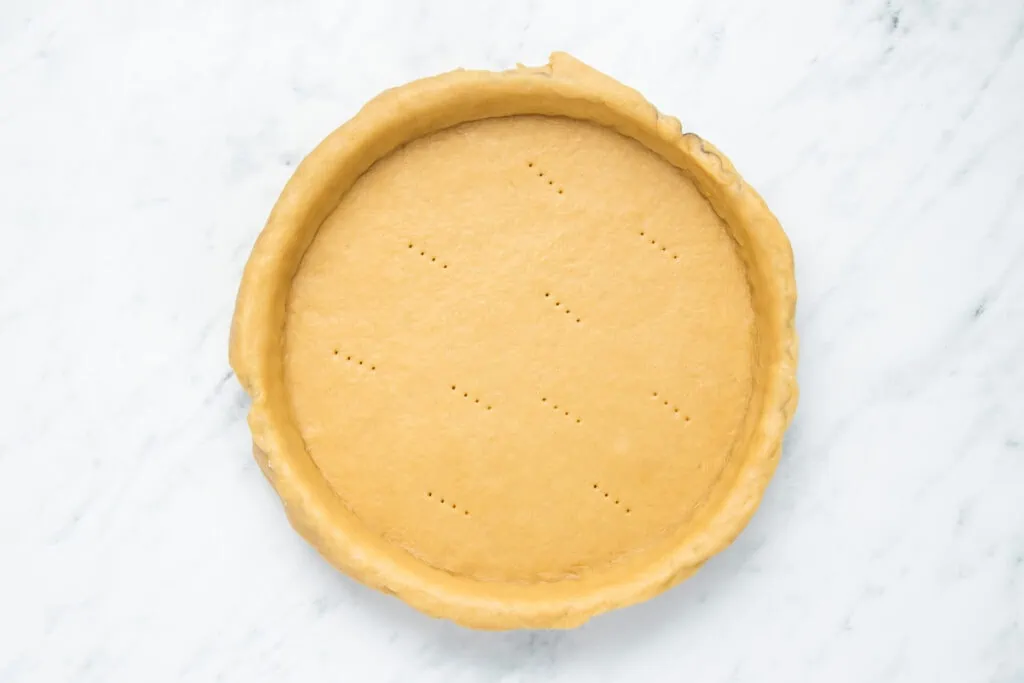
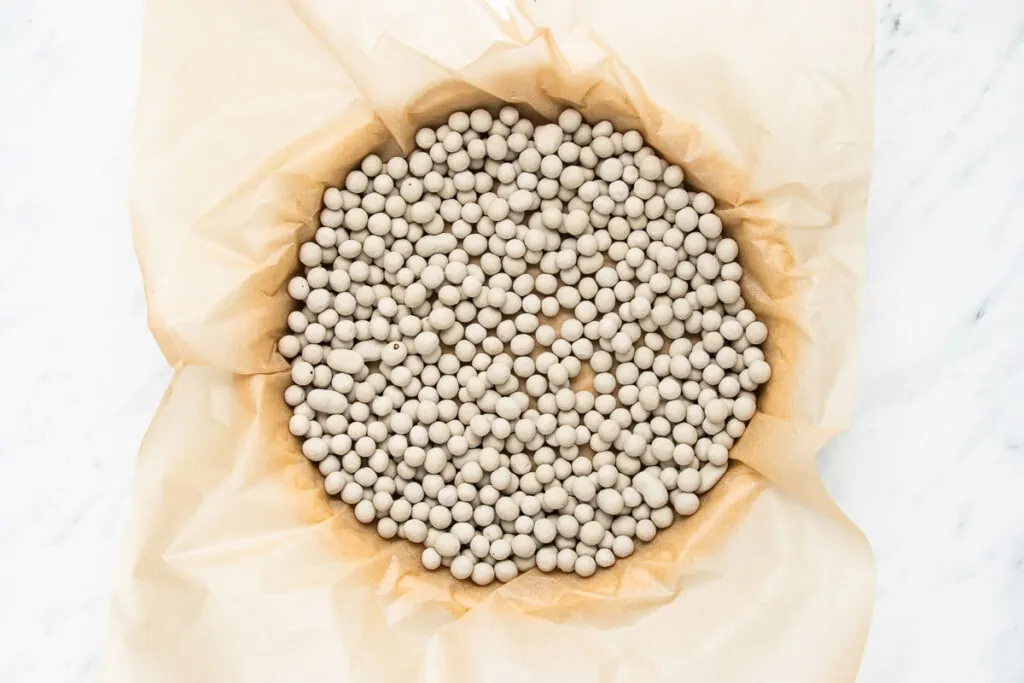
Bake for 15 minutes, then remove the baking beans and paper and bake for a further 5-10 minutes, until the pastry is cooked through and starting to go golden around the edges.
Whilst the pastry is still hot, carefully slice away the excess pastry with a sharp knife so you have a nice flat edge.
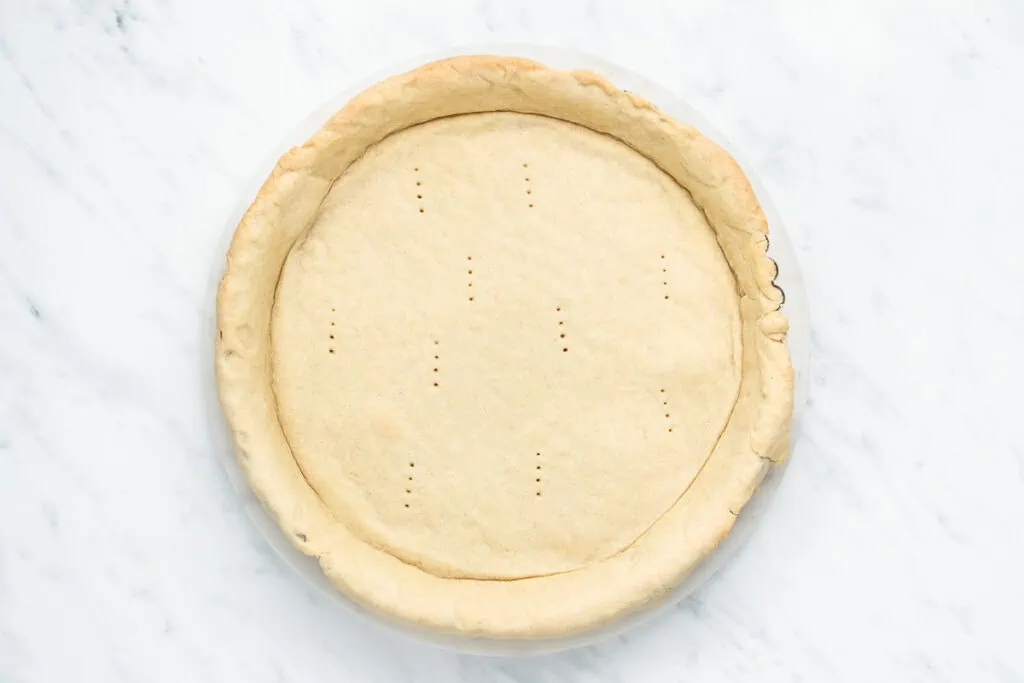
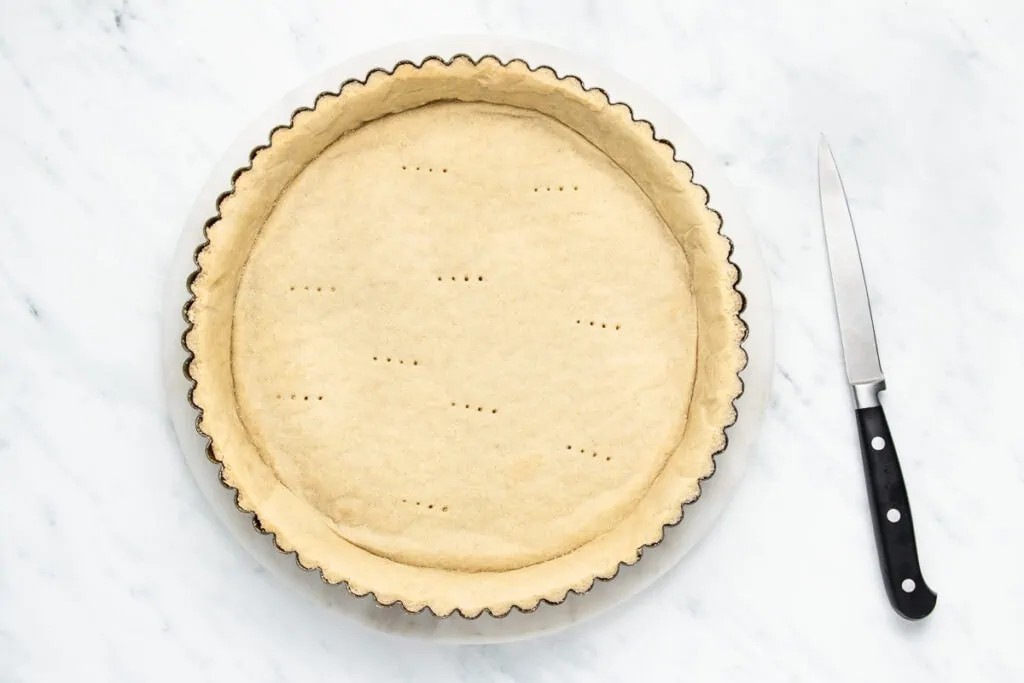
Leave the tart case to cool whilst you prep the filling. First, mix the flour with half of the milk to form a smooth paste. Set this aside.
Add the butter and the other half of the milk to a large saucepan and heat on a medium setting until the butter has completely melted.
Add the brown sugar and stir until dissolved.

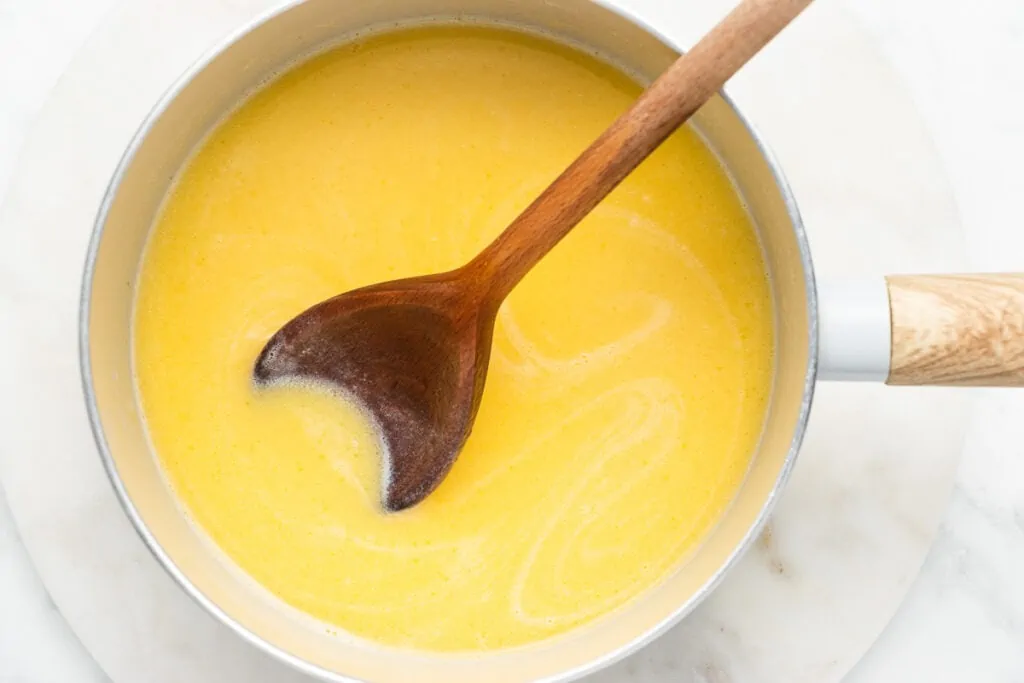
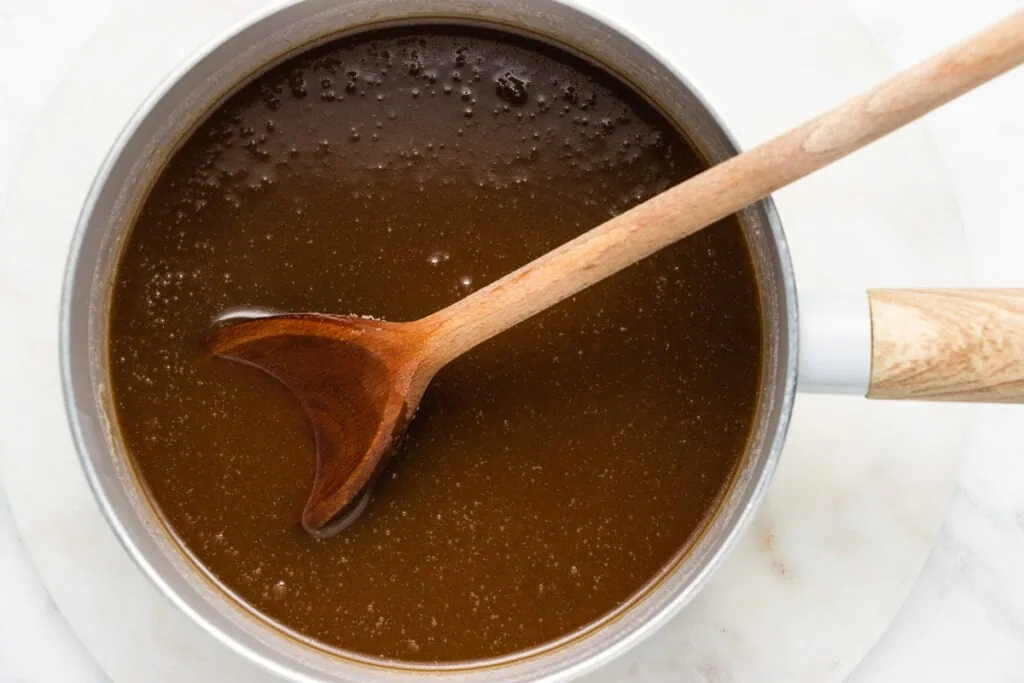
Add the flour paste and stir well. Cook until just starting to bubble and thicken – about 6-8 minutes.
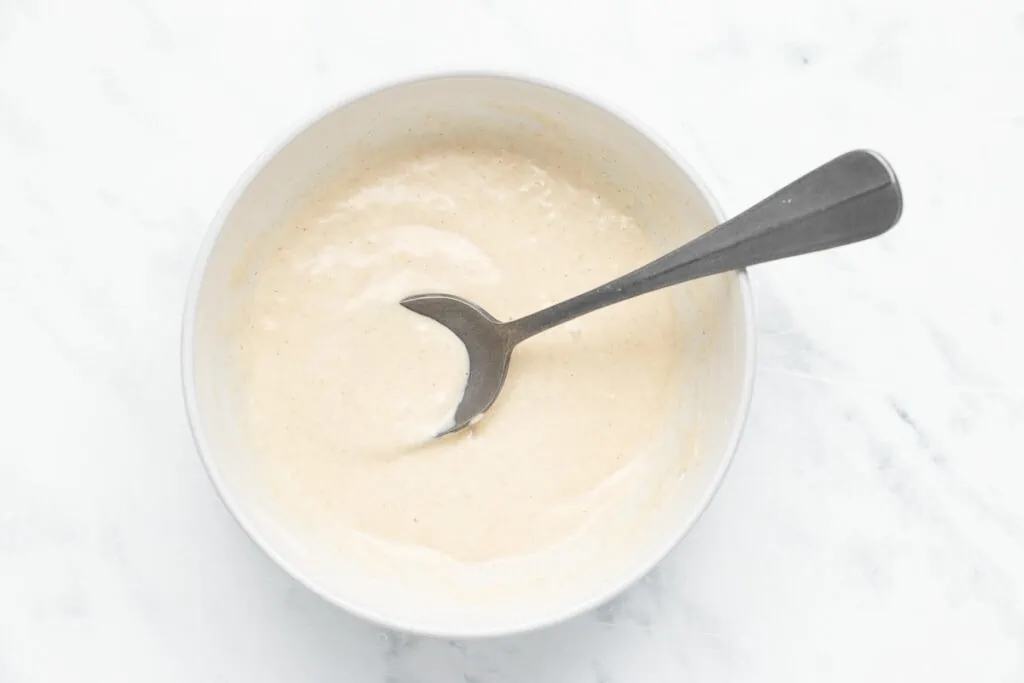
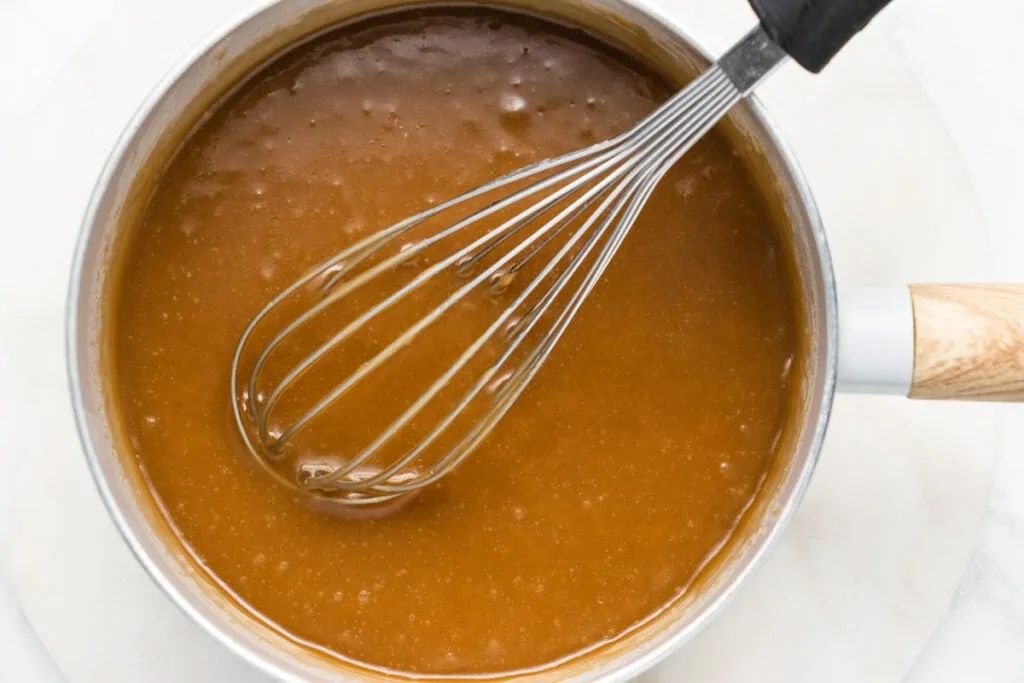
Remove the pan from the heat. If adding salt, stir this through now. Then cover the pan with a lid and leave to cool for 5 minutes.
Pour the butterscotch into the prepared pastry case and let it cool to room temperature.
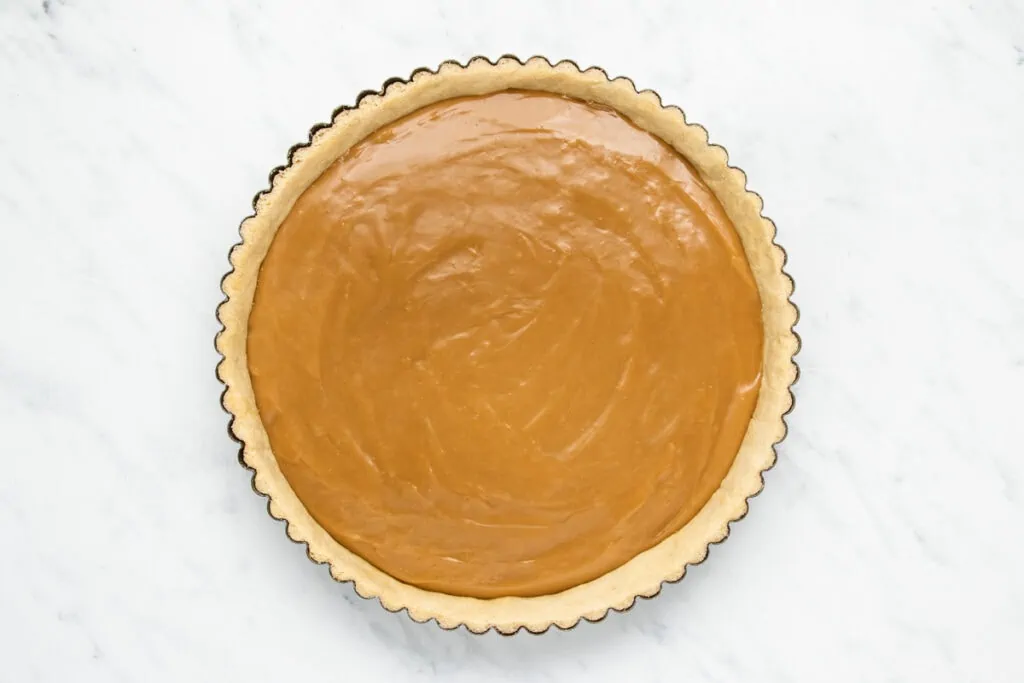
Chill in the fridge for at least 4 hours or preferably overnight.
Once ready to serve, melt the white chocolate in the microwave in 30 second bursts. Drizzle the chocolate all over the top of the tart.
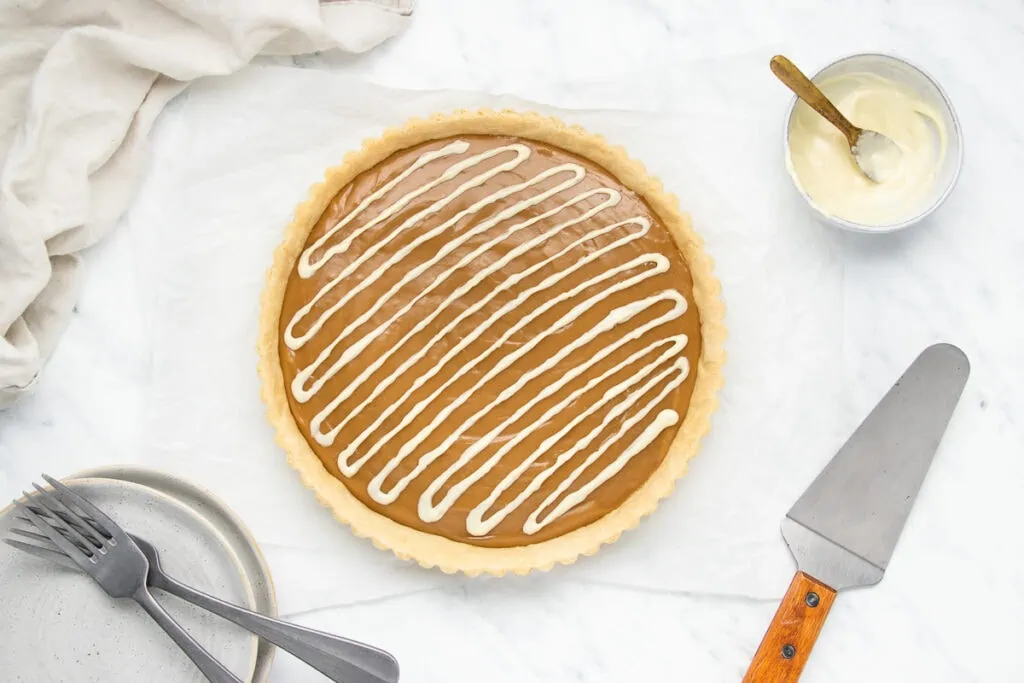
Slice up and enjoy!
How to serve Butterscotch Tart
Butterscotch Tart can be served like any other tart, on its own or with cream or custard. Some people even like to serve it with a scoop of vanilla ice cream! However, we prefer it on its own due to the sweetness of the tart.
How to store Butterscotch Tart
Butterscotch Tart can be stored for 5-6 days. Store it at room temperature in a cake tin or in an airtight container.
If you want it to last a little longer, pop it in the fridge for 7-9 days, but the tart is best served at room temperature rather than chilled so take it out around half an hour before you plan to eat it.
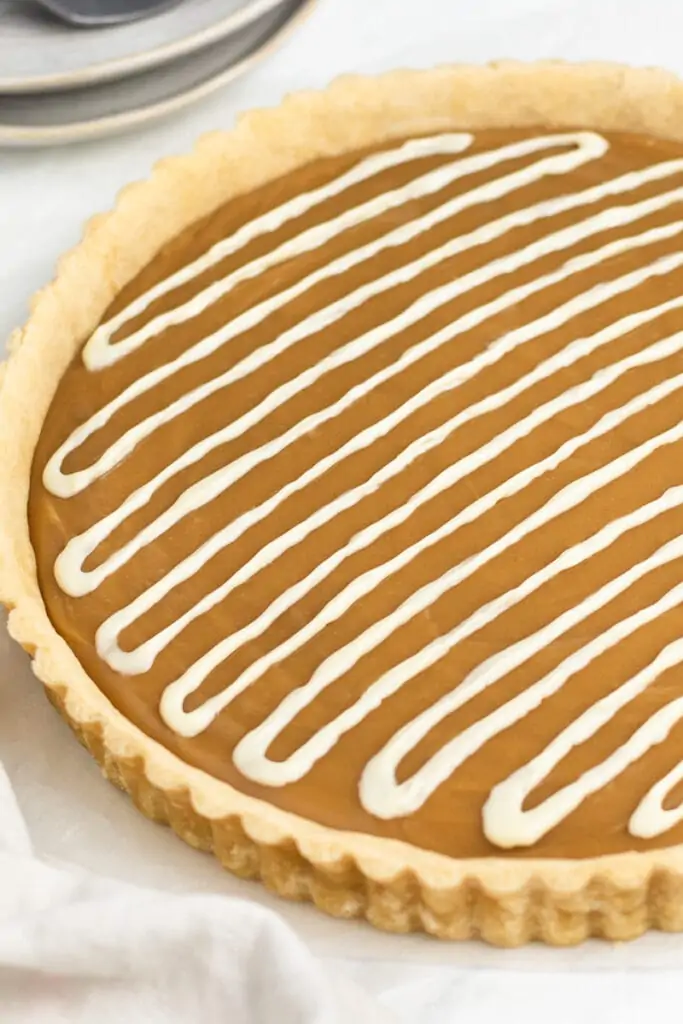
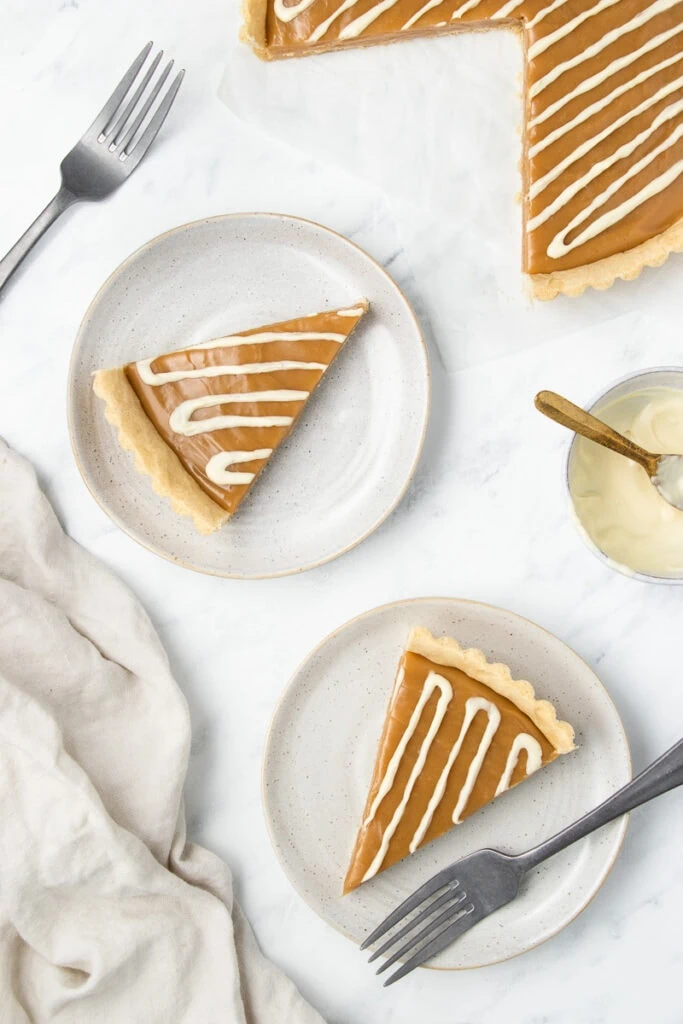
Can you freeze Butterscotch Tart?
Yes, you can freeze Butterscotch Tart for 3-4 months. Store it flat in an airtight container.
So whether you want a trip back into past puddings or just a delicious dessert, Butterscotch Tart is the pudding for you! We’ve really been loving our old-school recipes recently; what school dinner dish would you love us to make next?

Did you love this Old School pudding?
If this recipe pushes your memory into overdrive and gets your nostalgic tummy rumbling, then we have a whole bunch of recipes that you’re going to love!
Have a look at our Best School Puddings post for some absolute British school dinner classics. All you need now is pink custard!
Let us know in the comments if you’ve tried any of these pudding recipes before.
Old Fashioned Butterscotch Tart Recipe
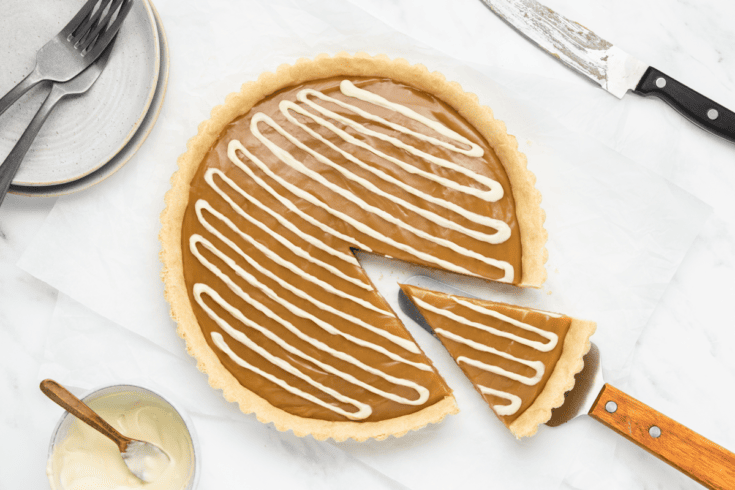
A Butterscotch Tart tastes like browned butter, caramelised cream, and sugar, sometimes with a touch of salt to cut through the sweetness.
This old school dessert may seem old-fashioned to some, but it's a classic that can easily be made modern with different decorations, and it's thoroughly delicious too!
Ingredients
For the Pastry
- 275g plain flour (2 cups)
- 125g unsalted butter (cold, cubed) (1/2 cup + 1 tbsp)
- 3 tbsp sugar
- 1 large egg
- 1-2 tbsp cold water
For the Filling
- 280g unsalted butter (1 ¼ cups)
- 170ml whole milk (2/3 cup)
- 280g light brown sugar (1 1/3 cups + 1 tbsp)
- 6 tbsp plain flour
- ¼ teaspoon salt (optional – for a salted butterscotch tart)
For Decoration
- ¼ cup white chocolate chips
Instructions
- To make the pastry, first add the flour and butter to the bowl of a food processor. Pulse until the mixture resembles breadcrumbs. You can also rub together the flour and butter with your hands if preferred (just make sure they’re cold).
- Transfer the mixture to the bowl of an electric stand mixer. Add the sugar and whisk briefly by hand to combine.
- Make a well in the centre of the mixture and add the egg and 1 tbsp of the water. Using the dough hook attachment, mix on a slow speed until it just starts to come together into a dough. If the dough is still looking too dry and crumbly, add the second tablespoon of water. If you don’t have a stand mixer, you can also use a fork to bring everything together.
- Use your hands to shape the dough into a ball. Don’t handle it more than you need to here or you may overwork the dough.
- Wrap the dough ball in cling film and place in the fridge to chill for 30 minutes.
- On a lightly floured surface, roll out the dough to approximately 0.5cm in thickness. Lay it over a 23cm fluted tart tin then push it down into the base and sides with your hands so it closely lines the tin. Cut away any loose edges, but leaving an overhang of about an inch or so.
- Prick the base of the pastry a few times with a fork, then place in the fridge to chill for another 30 minutes.
- Preheat the oven to 190C.
- Place a sheet of baking paper over the pastry, then cover with baking beans.
- Bake for 15 minutes, then remove the baking beans and paper and bake for a further 5-10 minutes, until the pastry is cooked through and starting to go golden around the edges.
- Whilst the pastry is still hot, carefully slice away the excess pastry with a sharp knife so you have a nice flat edge.
- Leave the tart case to cool whilst you prep the filling. First, mix the flour with half of the milk to form a smooth paste. Set this aside.
- Add the butter and the other half of the milk to a large saucepan and heat on a medium setting until the butter has completely melted.
- Add the brown sugar and stir until dissolved.
- Add the flour paste and stir well. Cook until just starting to bubble and thicken – about 6-8 minutes.
- Remove the pan from the heat. If adding salt, stir this through now. Then cover the pan with a lid and leave to cool for 5 minutes.
- Pour the butterscotch into the prepared pastry case and let it cool to room temperature.
- Chill in the fridge for at least 4 hours or preferably overnight.
- Once ready to serve, melt the white chocolate in the microwave in 30 second bursts. Drizzle the chocolate all over the top of the tart.
- Slice up and enjoy!
Notes
Can I add Salt to My Butterscotch Tart?
Yes, yes and yes! We're huge fans of salted caramel anything here at Scottish Scran. Adding a little salt to our recipe gives it that touch of savoury that can really help balance the sweetness.
We've added salt as an optional ingredient in the recipe in case you want to try a Salted Butterscotch Tart.
Different Toppings for Butterscotch Tart
Butterscotch Tart can be served without any toppings at all! However, if you want to decorate it a little, there are plenty of options.
- Chocolate Drizzle (white, milk, or dark)
- Popcorn (usually the salted variety)
- Piped Cream
- Pecans (or other nuts of your choice)
- Maltesers or other similar chocolates
- Chocolate shards or grated chocolate
If you’re looking for more old school recipes, check out these:
- Old School Cake Recipe
- Cornflake Tart Recipe
- Traditional Scottish Tablet
- Petticoat Tails Shortbread
- Classic Rock Cakes Recipe
- Easy Paris Buns Recipe
- Simple Chocolate Tiffin Recipe
Happy baking!
Sonja and Phil x
Pin for later!
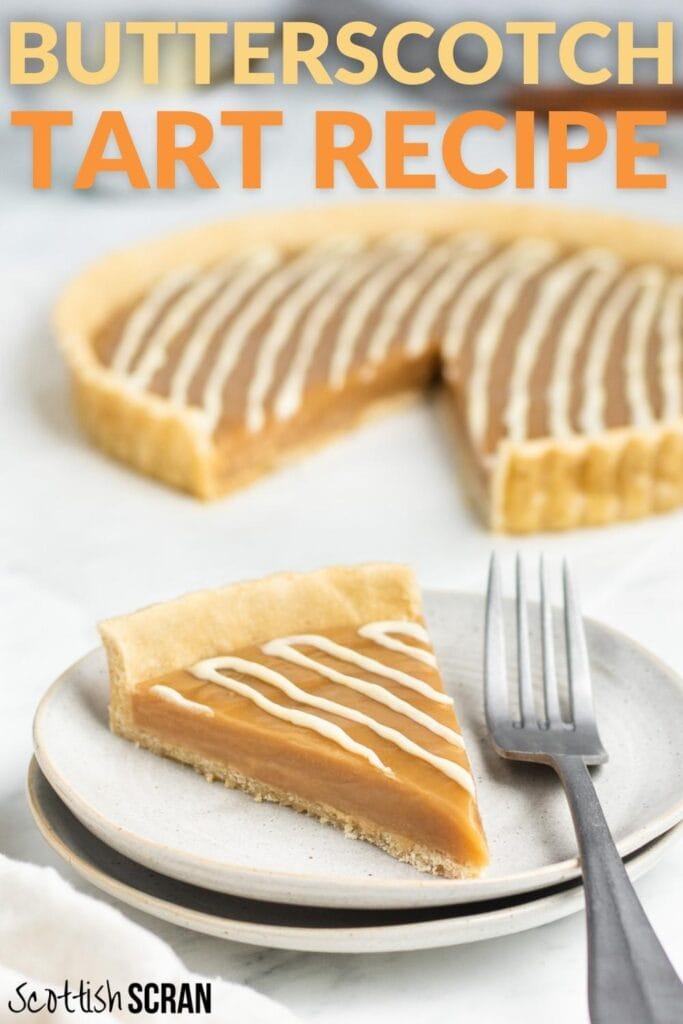

I’m a resident of Kent and have stumbled across your memories of Gypsy tart, which is still widely available here in the local bakeries and some people (including me) still make it at home.
The recipe for Gypsy Tart should contain (a small correction to your otherwise-excellent page) condensed milk rather than evaporated milk.
Hmmmm not sure I can agree about the condensed milk but not to worry. As a man of kent born and raised I’m glad this tasty pud is still available – Phil